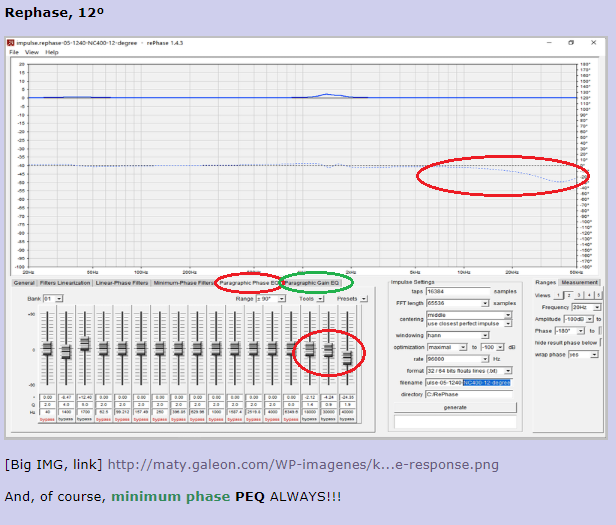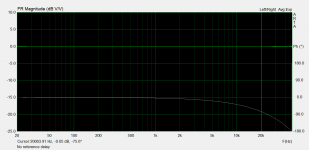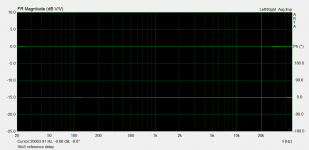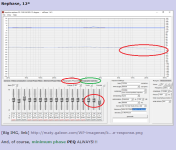Hi maty,
Sorry to say it looks you dont understand phase shift relations and by that mistake will make some very wrong subjective conclusions.
When you try emulate NC400 looks you use the 41º number which is wrong because there is used a AES-17 filter in that measurement, instead you should use the 18º number which is the amps reality input to output, also in emulation you only dial on phase domain but you need the same amplitude/phase relation that belongs to NC400, and also to emulate NC400 correct you need to now your own power amps amplitude/phase relation because its numbers cascade to listening session and therefor needs to be divided out relative to NC400 amplitude/phase relations in the rephase correction.
Also you publish a phase and impedance graph of your KEF Q100 speaker, hope you understand that the phase trace in that graph belongs or relate to the impedance trace and can not be compared to phase related to speakers response curve, phase swings in impedance graphs can be distortion related but we need them selective per tranducer to see that data where what you publish is a complicated sum of all the XO components and transducers.
Sorry to say it looks you dont understand phase shift relations and by that mistake will make some very wrong subjective conclusions.
When you try emulate NC400 looks you use the 41º number which is wrong because there is used a AES-17 filter in that measurement, instead you should use the 18º number which is the amps reality input to output, also in emulation you only dial on phase domain but you need the same amplitude/phase relation that belongs to NC400, and also to emulate NC400 correct you need to now your own power amps amplitude/phase relation because its numbers cascade to listening session and therefor needs to be divided out relative to NC400 amplitude/phase relations in the rephase correction.
Also you publish a phase and impedance graph of your KEF Q100 speaker, hope you understand that the phase trace in that graph belongs or relate to the impedance trace and can not be compared to phase related to speakers response curve, phase swings in impedance graphs can be distortion related but we need them selective per tranducer to see that data where what you publish is a complicated sum of all the XO components and transducers.
I suppose my class AB has almost flat phase response. Sure < 6º at 20 kHz as usual in class AB. No problema.
I publish ALL data I know. The key is that the difference was too much audible with 41º in my second system, what was important to me.
I will made a new test with 18º. But, the more important, everyone can made it too and decide for themself.
I publish ALL data I know. The key is that the difference was too much audible with 41º in my second system, what was important to me.
I will made a new test with 18º. But, the more important, everyone can made it too and decide for themself.
Last edited:
Could hope when you try those -12º then dial on amplitude domain too in that is how natural real world live analog sound and standard circuits works, for example in Rephase on "Minimum-Phase Filters" tab set a 1st order lowpass @94,4kHz is exactly -12º at 20kHz, suggest you skip those selective phase only corrections on"Paragraphic Phase EQ" tab in you are not on a task for linearize documented/measured real excess phase errors that for example can happen in speaker domain summing relative narrow passbands of multiple transducers to cover the wide audio band target.
Last edited:
I will do it exactly as I did with 41º, including the very small enhancement at 40 Hz, maintaining the same conditions. 18º and 12º. Rocket man track.
As I said before, anyone can verify it on their own. It would be interesting if someone with Hypex NC400 or NC500 added phase and did the test and tell us if he notice the difference and in that case if the sound is better or worse.
I am heating the system with loud / noisy music: Rory Gallagher - Photo-Finish (1978), Vinyl, Chrysalys, Germany
As I said before, anyone can verify it on their own. It would be interesting if someone with Hypex NC400 or NC500 added phase and did the test and tell us if he notice the difference and in that case if the sound is better or worse.
I am heating the system with loud / noisy music: Rory Gallagher - Photo-Finish (1978), Vinyl, Chrysalys, Germany
Last edited:
Rocket man
* 18º. Sound has less body. More clear but worse than without.
* 12º. Much better than before.
* Without. .... The BEST without any doubt.
With 12º is tolerable but when I remove it the difference is very evident. There is more musicality, the guitars are much more present, the instrumentation is more detailed / separate, the music fills the room.
I believed that the difference would be much smaller and that I would need to change the track, with greater dynamic range and only with acoustic instrumentation but it has not been necessary.
Now I think about the IcePower 1200AS2 and I am very glad that I did not buy it!!!
Again with 12º. Too much difference. Much less soundstage, depth, instrument separation...
Now without the 0.6 dB at 40 Hz. I will to try with 0.3 dB.
* 18º. Sound has less body. More clear but worse than without.
* 12º. Much better than before.
* Without. .... The BEST without any doubt.
With 12º is tolerable but when I remove it the difference is very evident. There is more musicality, the guitars are much more present, the instrumentation is more detailed / separate, the music fills the room.
I believed that the difference would be much smaller and that I would need to change the track, with greater dynamic range and only with acoustic instrumentation but it has not been necessary.
Now I think about the IcePower 1200AS2 and I am very glad that I did not buy it!!!
Again with 12º. Too much difference. Much less soundstage, depth, instrument separation...
Now without the 0.6 dB at 40 Hz. I will to try with 0.3 dB.
Last edited:
Hypex NC400, 18º
[Big IMG, link] http://maty.galeon.com/WP-imagenes/kef-q100/Hypex-NC400-SPL-phase-18-degree.png
Rephase, 12º
[Big IMG, link] http://maty.galeon.com/WP-imagenes/...with-Hypex-NC400-12-degree-phase-response.png
And, of course, minimum phase PEQ ALWAYS!!!
PS: Cocodrile rock, I follow the music with my feet. Daniel, without 40 Hz, too bass. Maybe is the remastering the guilty. Remastered By – Bob Ludwig.
An externally hosted image should be here but it was not working when we last tested it.
[Big IMG, link] http://maty.galeon.com/WP-imagenes/kef-q100/Hypex-NC400-SPL-phase-18-degree.png
Rephase, 12º
An externally hosted image should be here but it was not working when we last tested it.
[Big IMG, link] http://maty.galeon.com/WP-imagenes/...with-Hypex-NC400-12-degree-phase-response.png
And, of course, minimum phase PEQ ALWAYS!!!
PS: Cocodrile rock, I follow the music with my feet. Daniel, without 40 Hz, too bass. Maybe is the remastering the guilty. Remastered By – Bob Ludwig.
Last edited:
In addition to possible AES-17 filter usage, there is also DUT latency to consider. Frequency-independent effects can confuse folks evaluating phase response graphs where the test conditions were unknown. (A proper test setup is not as straightforward as it might seem.)
The NC400 has approximately 10uS input-to-output latency. This CAN NOT be ignored during objective measurements and MUST be taken into account in the test setup when performing differential measurements to evaluate phase response.
Two plots attached:
A plot of the phase response of my Hypex NC500 amplifier from input to output. (27db voltage gain removed for clarity.)
Note the 75 degree "phase shift" at 20khz. However, that is NOT the true phase response of the amplifier.
A plot with a 10uS pure delay added into the reference channel of the differential measurement to eliminate the latency of the amplifier from the measurement. This yields the TRUE phase response of the NC500 amplifier.
Dave.
The NC400 has approximately 10uS input-to-output latency. This CAN NOT be ignored during objective measurements and MUST be taken into account in the test setup when performing differential measurements to evaluate phase response.
Two plots attached:
A plot of the phase response of my Hypex NC500 amplifier from input to output. (27db voltage gain removed for clarity.)
Note the 75 degree "phase shift" at 20khz. However, that is NOT the true phase response of the amplifier.
A plot with a 10uS pure delay added into the reference channel of the differential measurement to eliminate the latency of the amplifier from the measurement. This yields the TRUE phase response of the NC500 amplifier.
Dave.
Attachments
Why write "And, of course, minimum phase PEQ ALWAYS" there maty, such argument qualify in nonsense big misunderstanding, marked with red markings is nothing but selective phase domain only manipulation, you have to use the other tab marked with green to get pure minimum phase correction.

Attachments
Last edited:
Year that speaker minimum phase correction had been visible all the time in the graphs, still it don't hang together write 12º in headline over the graph and claim minimum phase below also because you have to use minimum phase or a hybrid to emulate NC400 graph because its amplitude actual roll off clear and visible in the graph but you continue emulate dial only on phase domain.
Last edited:
I do not need to do any further proof. Whoever wants to do it already knows how and with the parameters he wants. The difference is very evident, at least in my second system.
I am hallucinating with the improvement of a record that I heard again not many weeks ago: Alberta Hunter - Amtrak Blues (1980), Vinyl, Columbia, US
I am hallucinating with the improvement of a record that I heard again not many weeks ago: Alberta Hunter - Amtrak Blues (1980), Vinyl, Columbia, US
For me this is a final issue. Years ago I have decided to avoid Hypex nCore and the Hypex SMPS1200 (with such cheap components).
Of class D I am only interested in the PURIFI 1ET400A kit and the BOSC Monoblock Class-D GaN.
If I made the kit, with Cresnet SMPS is the idea. Of course, I will not be among the first, that others do it for me and tell their experiences. Maybe the PURIFI SMPS be a reality and they do not skimp so much on components of a certain quality.
I have already done my sims, that others do theirs and make their own decisions.
Of class D I am only interested in the PURIFI 1ET400A kit and the BOSC Monoblock Class-D GaN.
If I made the kit, with Cresnet SMPS is the idea. Of course, I will not be among the first, that others do it for me and tell their experiences. Maybe the PURIFI SMPS be a reality and they do not skimp so much on components of a certain quality.
I have already done my sims, that others do theirs and make their own decisions.
Last edited:
VERIFIED.
I can hear very easy the phase shift of Hypex NC400. I had emulated with rePhase. The sound is worse without any doubt. Without life. Rocket man, from Diamonds (2017), by Elton John, vinyl of course. With my modded KEF Q100 5.25" coaxial speakers.
It reminded me of the difference I appreciated when I used a linear phase PEQ instead of a minimum phase PEQ, much better with the last.
You cannot be serious. Do you think that adding phase in the digital domain will work exactly in the same way as linear phase in an analog circuit and not modify the sound in otherwise different ways?
With rePhase you can modify the phase without modify the SPL response or maybe am I wrong?
I have not written about how the amp modifies the final phase with my KEF Q100. I have just put the data. It is logical that a simple sum is not correct, hence the need of the emulation.
Same SPL, same frequency. Only changes the phase. rePhase is a very good tool! More, the minimum phase PEQ offers better sound that the JRiver MC equivalent. And it is free!!!
A wave only has those three parameters.
I have not written about how the amp modifies the final phase with my KEF Q100. I have just put the data. It is logical that a simple sum is not correct, hence the need of the emulation.
Same SPL, same frequency. Only changes the phase. rePhase is a very good tool! More, the minimum phase PEQ offers better sound that the JRiver MC equivalent. And it is free!!!
A wave only has those three parameters.
Last edited:
To finish, it is well known or it should be known that the output phase in an amplifier should be as flat as possible, and not only in the audible band, but at least it should not exceed 6 degrees at 20 kHz.
The phase change modifies our perception of sound. How much? it is arguable. In a system as complex as audio will depend on how its components interact.
The problem, I think, as with RF / EMI, lies in the EE formation, at least in Spain but I think it is widespread so I have been reading on the audio forums for some years.
The phase change modifies our perception of sound. How much? it is arguable. In a system as complex as audio will depend on how its components interact.
The problem, I think, as with RF / EMI, lies in the EE formation, at least in Spain but I think it is widespread so I have been reading on the audio forums for some years.
Last edited:
- Home
- Amplifiers
- Class D
- Phase shift in class D amplifiers. How it affects the sound?


